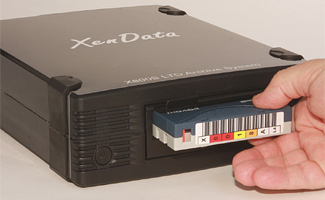From Tapeless Back to Tape
SEATTLE
Helical scan broadcast cassette videotapes have hardly been the ideal archiving medium throughout the past 40 or so years, but newsrooms shot on videotape, edited on videotape, and kept their invaluable news archives on videotape.
Even as broadcasters turned to editing on disk servers, the videotapes remained as the archives. "The footage of whatever the news guys came back with would get ingested for editing," said Phil Storey, CEO of XenData, a digital archiving provider in Walnut Creek, Calif., "but the videotape was still there as a byproduct and it went into the archives."

Xendata will introduce its X800 archiving system at the 2010 NAB Show But now with the turn toward tapeless acquisition, there is no videotape byproduct to begin with, and the acquisition media is too expensive to use once and relegate to the shelf for posterity. Broadcasters have had to migrate to some other form of storage, and though the rest of their workflow is be-coming tapeless, for long-term archiving the answer is increasingly to use tape.
OPEN STANDARDS ALTERNATIVE
LTO (Linear Tape-Open) data tape was developed in the late 1990s as an open standards alternative to then dominant proprietary magnetic tape for-mats. "LTO is the standard in the IT industry," said Mark Ostlund, vice president of sales and marketing for Cache-A, a Morgan Hill, Calif.-based provider of archiving systems. "So if you look at what Wall Street is using, what the government is using, what enterprise business is using, it's all LTO data tape for long-term archival storage."
The 30-year life expectancy is certainly one reason to use LTO. And affordability is a key. The current generation of LTO tape cartridges is LTO 4, which holds 800 GB of material. "You can buy an LTO 4 tape cartridge for around $35, and at DV50, that's about 35 hours of material," said XenData's Storey. "So you're getting an hour of kind of lower res HD for a dollar."
That cost is about to change for the better soon, as 1.6 TB LTO 5 tape cartridges are becoming available. Assuming they follow the same market forces that affect all of IT, their price will drop to around that same $35 with twice the capacity. (Migrating to LTO 5 will require replacing legacy LTO tape drives with LTO 5 drives. They will be backward-compatible through two generations, meaning they will be able to read and write to both LTO 3 and LTO 4 cas-settes as well as the new LTO 5 cassettes.)
Back in the editing room—or increasingly at the journalist's desktop which has replaced the edit room—it's good to know that all the archives are available on LTO tape. Knowing what archives are where requires a Media Asset Management (MAM) system with careful attention to adding cataloguing metadata at ingest and any other points along the way.
There's still a strong case to be made for having at least some magnetic hard disk storage dedicated to archive footage that is current and used often. The hard drive doesn't require someone to retrieve a data tape and insert it in a drive. Every newsroom is different, both in what they need and what they can afford, so each will have its own individual strategy as to what is available on spinning disk and what's only available on data tape.
A strong case can be made for making sure all archives exist on data tape. "As a permanent storage, from an archival perspective, the hard disk is prob-lematic," said Josef Marc, vice president, customer engineering, for Front Porch Digital, a Louisville, Colo.-based provider of content storage management technology. "There's the cost of keeping the spinning disk spinning… and the hard disk is exposed to the risk of loss, because there are a number of users who could do damage to the files with their permissions." He said products such as the company's DIVArchive can offer protection against such file dam-age.
DEDUPLICATION
To get the most out of hard disk storage, there's a technology offered by some vendors called deduplication.
A well-worn example of deduplication cites an e-mail archive with a certain 1 MB file that's attached to 100 emails, taking up 100 MB of storage. Deduplication would remove all but one copy of that file, but link all the e-mails to it. In IT talk, that would be a 99:1 deduplication ratio.
Squeezing duplicative bits out of video files has not proven so easy, according to Shawn Klein, director of software partner development at Quantum, an ar-chive solutions provider in San Jose, Calif. "We've run quite a few different video formats through our deduplication technology. Some of them we get more de-dup out of it than other formats, and believe it or not, it depends all the way down to the codec of the format."
He said there is good storage savings to be had through the technique of single-instance store, making sure you have one copy of a particular video file. An LTO tape library might have stored the same video file a number of times, and a MAM can squeeze the extra copies out in an automated process of recopying LTO tapes.
Then there's the broad, if hazy concept in archival storage being touted, "the cloud." Here, a service vendor stores the library off-site where it's available via net-work. But as more than one vendor in this story noted, the nice thing about an LTO tape is you can see and touch it. The cloud will have to earn some trust first.
Get the TV Tech Newsletter
The professional video industry's #1 source for news, trends and product and tech information. Sign up below.
